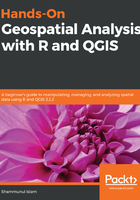
apply
apply works on arrays or matrices and gives us an easier way to compute something row-wise or column-wise. For the apply() function, this row- or column-wise consideration is denoted by a margin. The apply() function takes the following form: apply(data, margin, function). This data has to be an array or a matrix, and the margin can be either 1 or 2, where 1 stands for a row-wise operation and 2 stands for a column-wise operation. We will work with the matrix all_prices, which has the following structure:

Here, we have a record of prices of three different items in three different months (January, March, and June), where a row represents the prices of an item in three different months and a column represents the prices of three different items in any single month. Now, if we want to know which item's price fluctuated most over these three months, we would have to compute a standard deviation row-wise for each row. We can do this very easily using margin = 1 in apply().
apply(all_prices, 1, sd)
We can see the standard deviation for these three items as follows:

Now suppose we want to know the month-wise total cost of all three items. As every column corresponds to different months, we can apply apply() with margin = 2 and a function mean to achieve this:
apply(all_prices, 2, sum)
This gives the sum for all three months in a vector:

We see that the total prices were the highest in June (the third column), totaling 78.